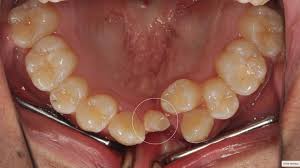
Premolar tooth formation. The first permanent molar teeth appear around age six. These four molars erupt behind the child’s baby teeth, two in each jaw. The deciduous teeth that have exfoliated (fallen out/lost) leave spaces for the emergence of other permanent teeth, including the incisors, canines, and premolars.
PREMOLAR TOOTH FORMATION
Premolars, Often referred to as bicuspids, these vital parts of the human dentition are important for speech, chewing, and general oral health. To appreciate premolar teeth’s importance in the dental arch, one must comprehend how they grow and develop. Let’s examine the intriguing process of premolar tooth development, from emergence to operation:
1. Formation and Development;

PREMOLAR TOOTH FORMATION
Premolars are the transitional teeth located between the anterior incisors and canines in the front of the mouth and the molars at the back. Humans typically have eight premolars, with four in each dental arch—two maxillary (upper) premolars and two mandibular (lower) premolars on each side.
The process of premolar formation begins during the prenatal period, with the initiation of tooth development in the embryonic stage. Tooth buds for the premolars form between the ages of 3 to 6 years, with eruption occurring later in childhood and adolescence.
Premolars undergo a complex process of morphogenesis and mineralization, guided by genetic factors and signaling molecules. They develop from the dental lamina, a specialized epithelial structure that gives rise to the entire dentition. As the premolar tooth bud grows and matures, it undergoes differentiation into enamel, dentin, pulp, and other dental tissues, ultimately forming a functional tooth capable of withstanding the forces of chewing and grinding.
2. Function and Role in Mastication;

PREMOLAR TOOTH FORMATION
Premolars are well-suited for chewing and grinding food, thanks to their distinct morphology and arrangement of cusps and ridges. Unlike incisors, which are designed for cutting and biting, and molars, which are specialized for crushing and grinding, premolars exhibit a combination of these functions.
Maxillary premolars typically have two cusps (buccal and lingual) and are flatter in shape compared to mandibular premolars. Which often have three cusps (buccal, lingual, and occlusal). These anatomical variations reflect the diverse dietary needs and chewing patterns of individuals.
During mastication, premolars work in concert with other teeth to break down food into smaller particles. Facilitating digestion and nutrient absorption. Their strategic location in the dental arch allows them to exert precise occlusal forces and contribute to the efficient processing of food.
3. Importance of Dental Occlusion:

PREMOLAR TOOTH FORMATION
Premolars play a crucial role in maintaining proper dental occlusion. Or the alignment and contact between the upper and lower teeth when the jaws are closed. Their location and morphology contribute to the stability and functionality of the bite. Ensuring harmonious intercuspal relationships and efficient distribution of occlusal forces.
Other importance;
Premolar teeth also serve as anchors for dental prostheses, such as bridges and implants, in cases of missing teeth. Their presence helps preserve the integrity of the dental arch. And prevents neighboring teeth from shifting or drifting out of alignment, which can lead to occlusal problems and malocclusion.
Summary
Dental professionals and patients alike can appreciate the intricate beauty and functionality of these transitional teeth within the human dentition by understanding the formation, function, and significance of premolars. Premolar tooth growth represents a remarkable process of embryonic development, morphogenesis, and mineralization, resulting in functional teeth essential for chewing, speech, and maintaining proper dental occlusion.